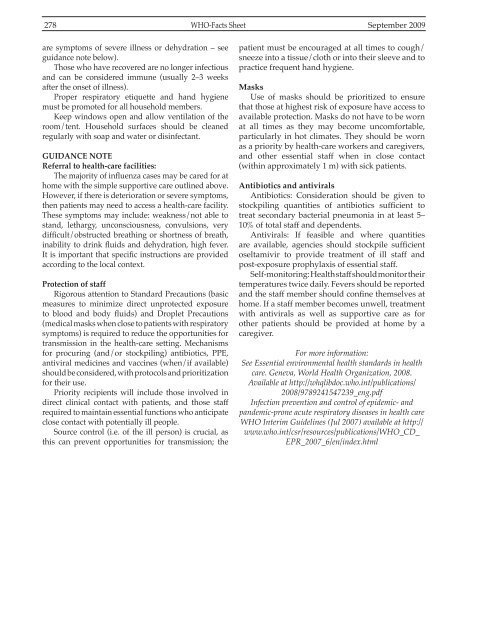Vol 41 # 3 September 2009 - Kma.org.kw
Vol 41 # 3 September 2009 - Kma.org.kw
Vol 41 # 3 September 2009 - Kma.org.kw
You also want an ePaper? Increase the reach of your titles
YUMPU automatically turns print PDFs into web optimized ePapers that Google loves.
278<br />
WHO-Facts Sheet <strong>September</strong> <strong>2009</strong><br />
are symptoms of severe illness or dehydration – see<br />
guidance note below).<br />
Those who have recovered are no longer infectious<br />
and can be considered immune (usually 2–3 weeks<br />
after the onset of illness).<br />
Proper respiratory etiquette and hand hygiene<br />
must be promoted for all household members.<br />
Keep windows open and allow ventilation of the<br />
room/tent. Household surfaces should be cleaned<br />
regularly with soap and water or disinfectant.<br />
GUIDANCE NOTE<br />
Referral to health-care facilities:<br />
The majority of influenza cases may be cared for at<br />
home with the simple supportive care outlined above.<br />
However, if there is deterioration or severe symptoms,<br />
then patients may need to access a health-care facility.<br />
These symptoms may include: weakness/not able to<br />
stand, lethargy, unconsciousness, convulsions, very<br />
difficult/obstructed breathing or shortness of breath,<br />
inability to drink fluids and dehydration, high fever.<br />
It is important that specific instructions are provided<br />
according to the local context.<br />
Protection of staff<br />
Rigorous attention to Standard Precautions (basic<br />
measures to minimize direct unprotected exposure<br />
to blood and body fluids) and Droplet Precautions<br />
(medical masks when close to patients with respiratory<br />
symptoms) is required to reduce the opportunities for<br />
transmission in the health-care setting. Mechanisms<br />
for procuring (and/or stockpiling) antibiotics, PPE,<br />
antiviral medicines and vaccines (when/if available)<br />
should be considered, with protocols and prioritization<br />
for their use.<br />
Priority recipients will include those involved in<br />
direct clinical contact with patients, and those staff<br />
required to maintain essential functions who anticipate<br />
close contact with potentially ill people.<br />
Source control (i.e. of the ill person) is crucial, as<br />
this can prevent opportunities for transmission; the<br />
patient must be encouraged at all times to cough/<br />
sneeze into a tissue/cloth or into their sleeve and to<br />
practice frequent hand hygiene.<br />
Masks<br />
Use of masks should be prioritized to ensure<br />
that those at highest risk of exposure have access to<br />
available protection. Masks do not have to be worn<br />
at all times as they may become uncomfortable,<br />
particularly in hot climates. They should be worn<br />
as a priority by health-care workers and caregivers,<br />
and other essential staff when in close contact<br />
(within approximately 1 m) with sick patients.<br />
Antibiotics and antivirals<br />
Antibiotics: Consideration should be given to<br />
stockpiling quantities of antibiotics sufficient to<br />
treat secondary bacterial pneumonia in at least 5–<br />
10% of total staff and dependents.<br />
Antivirals: If feasible and where quantities<br />
are available, agencies should stockpile sufficient<br />
oseltamivir to provide treatment of ill staff and<br />
post-exposure prophylaxis of essential staff.<br />
Self-monitoring: Health staff should monitor their<br />
temperatures twice daily. Fevers should be reported<br />
and the staff member should confine themselves at<br />
home. If a staff member becomes unwell, treatment<br />
with antivirals as well as supportive care as for<br />
other patients should be provided at home by a<br />
caregiver.<br />
For more information:<br />
See Essential environmental health standards in health<br />
care. Geneva, World Health Organization, 2008.<br />
Available at http://whqlibdoc.who.int/publications/<br />
2008/97892<strong>41</strong>547239_eng.pdf<br />
Infection prevention and control of epidemic- and<br />
pandemic-prone acute respiratory diseases in health care<br />
WHO Interim Guidelines (Jul 2007) available at http://<br />
www.who.int/csr/resources/publications/WHO_CD_<br />
EPR_2007_6/en/index.html
















